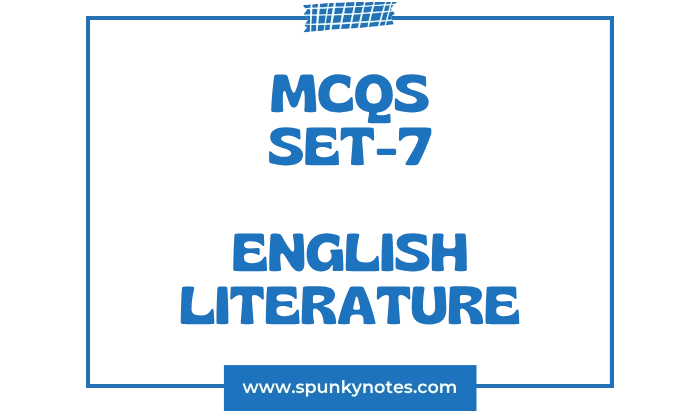

Estimated Reading Time: 16 min
English Literature MCQs
Set-7
1. Which character is depicted as despicable in The Prologue to The Canterbury Tales?
A. Pardoner
B. Parson
C. Knight
D. Clerk
2. “My lute, awake! Perform the last / Labour that thou and I shall fight.” Who wrote these lines?
A. Sir Philip Sidney
B. Henry Howard, Earl of Surrey
C. Edmund Spenser
D. Sir Thomas Wyatt
3. Which of the following Shakespearean Tragedies has the character named Bianca?
A. Macbeth
B. Othello
C. King Lear
D. Romeo and Juliet
4. Name the comic character in Romeo and Juliet.
A. Mercutio
B. Tybalt
C. Paris
D. Friar Laurence
5. The morality plays were first performed in England in the:
A. 13th Century
B. Early 14th Century
C. Late 14th Century
D. 16th Century
6. The Cardinal is a character in:
A. The White Devil
B. The Duchess of Malfi
C. Volpone
D. The Changeling
7. “My face in thine eye, thine in mine appears, / And true plaine hearts doe in the faces rest, / Where can we find two better hemispheres / Without sharp North, without declining West ?” These lines are written by:
A. Andrew Marvell
B. George Herbert
C. Henry Vaughan
D. John Donne
8. Hudibras was written by:
A. Samuel Butler
B. John Dryden
C. Alexander Pope
D. John Milton
9. Name the play, which Dryden wrote as an imitation of Shakespeare’s Antony and Cleopatra.
A. The Indian Queen
B. All for Love
C. Aureng-Zebe
D. The Assignation
10. The Advancement of Learning is written by:
A. John Locke
B. Thomas Hobbes
C. David Hume
D. Francis Bacon
11. In which of the following poems, the supernatural machinery is employed?
A. An Essay on Criticism
B. Absalom and Achitophel
C. The Rape of the Lock
D. Dunciad
12. The Battle of the Books has the major thematic concern of
A. The conflict between epic and drama
B. The battle between the Whig and Tory parties
C. The conflict between the ancient and the modern
D. The struggle between the rich and the poor
13. In which play is Mrs. Malaprop a character?
A. She Stoops to Conquer
B. The Rivals
C. The School for Scandal
D. The Way of the World
14. Dr. Johnson’s analysis of metaphysical poetry is found in:
A. The Rambler
B. A Dictionary of the English Language
C. Life of Cowley
D. Rasselas
15. Songs of Innocence is written by
A. S.T. Coleridge
B. William Blake
C. William Wordsworth
D. John Keats
16. Identify the poet who wrote, “Where are the songs of Spring? Ay, where are they? / Think not of them, thou hast thy music too”
A. P. B. Shelley
B. W. B. Yeats
C. William Wordsworth
D. John Keats
17. The dominant note of Wordsworth’s poetry is :
A. Didactic
B. Melancholic
C. Satirical
D. Restorative
18. Which of the following is considered an autobiographical poem of William Wordsworth?
A. The Excursion
B. Lines Composed Above Tintern Abbey
C. The Prelude
D. The Ruined Cottage
19. “We look before and after / Pine for what is not.” These lines are from:
A. Keats
B. Byron
C. Wordsworth
D. Shelley
20. Who is the author of Manfred and Cain?
A. Byron
B. Shelley
C. Keats
D. Scott
21. Who has written ‘Indian Jugglers’?
A. S.T. Coleridge
B. Charles Lamb
C. W. B. Yeats
D. William Hazlitt
22. “Ah, love, let us be true / To one another! For the world, which seems / To lie before us, like a land of dreams, / So various, so beautiful, so new” These lines are written by:
A. Tennyson
B. Arnold
C. Swinburne
D. Browning
23. “Sunset and evening star / And one clear call for me” These lines occur in this poem:
A. In Memoriam
B. Ulysses
C. Crossing the Bar
D. The Charge of the Light Brigade
24. Charles Dickens’ Hard Times centrally deals with:
A. Childhood poverty
B. The legal system
C. The French Revolution
D. Social and industrial problems
25. The young man that Dorothea falls in love with is :
A. Will Ladislaw
B. Mr. Casaubon
C. Tertius Lydgate
D. Fred Vincy
26. The Strange Case of Dr. Jekyll and Mr. Hyde is a fictional work of
A. Robert Stevenson
B. Bram Stoker
C. Edgar Allan Poe
D. Henry James
27. Who had coined the phrase ‘stream of consciousness’?
A. Carl Jung
B. William James
C. Sigmund Freud
D. Virginia Woolf
28. Seven Types of Ambiguity is written by:
A. F. R. Leavis
B. Cleanth Brooks
C. William Empson
D. I. A. Richards
29. Choose the option that states the correct chronological order of the publication of the novels mentioned.
A. The Rainbow-Sons and Lovers-Women in Love-Lady Chatterley’s Lover
B. Women in Love-The Rainbow-Sons and Lovers-Lady Chatterley’s Lover
C. Sons and Lovers-The Rainbow-Lady Chatterley’s Lover-Women in Love
D. Sons and Lovers-Women in Love-The Rainbow-Lady Chatterley’s Lover
30. “God is in heaven and all is right with the world.” This line is from:
A. Pippa Passes
B. Rabbi Ben Ezra
C. The Ring and the Book
D. My Last Duchess
31. Lady Bracknell is a character in:
A. The Importance of Being Earnest
B. Lady Windermere’s Fan
C. An Ideal Husband
D. A Woman of No Importance
32. Who among the following did not belong to the Bloomsbury Group ?
A. E. M. Forster
B. Virginia Woolf
C. Lytton Strachey
D. D. H. Lawrence
33. Time Passes’ is the title of a part of the novel:
A. Ulysses
B. Jacob’s Room
C. To the Lighthouse
D. Mrs. Dalloway
34. The Playboy of the Western World has the setting of:
A. a Mayo inn
B. a Dublin city pub
C. the Mayo coast
D. a remote Aran island
35. Which of the following is not a novel by Doris Lessing?
A. The Grass is Singing
B. The Golden Notebook
C. Under the Net
D. Shikasta
36. “The Mirror and the Sea’ is a poem by:
A. Philip Larkin
B. Seamus Heaney
C. Ted Hughes
D. R.S. Thomas
37. Identify an Absurd play from the following:
A. The Birthday Party
B. Waiting for Lefty
C. Look Back in Anger
D. Juno and the Paycock
38. Who is the exponent of the ‘epic theatre’?
A. Antonin Artaud
B. Brecht
C. Stanislavski
D. Ionesco
39. The Duke and the Dauphin are characters in:
A. The Adventures of Huckleberry Finn
B. Moby Dick
C. The Scarlet Letter
D. The Last of the Mohicans
40. What does Emily Dickinson write about in her poems?
A. Nature
B. Science
C. Christianity
D. Death and Immortality
41. Wole Soyinka hails from:
A. Europe
B. Africa
C. Asia
D. The Caribbean
42. Mahesh Dattani won the Sahitya Akademi Award for:
A. Fiction
B. Drama
C. Poetry
D. Criticism
43. Recognition and Peripeteia are the features of a good plot of tragedy according to:
A. Plato
B. Aristotle
C. Longinus
D. Sidney
44. Which English critic strongly defended Shakespeare’s violation of classical unities?
A. Dr. Johnson
B. John Dryden
C. Alexander Pope
D. Matthew Arnold
45. The Second Sex is a book by:
A. Virginia Woolf
B. Julia Kristeva
C. Betty Friedan
D. Simone de Beauvoir
46. ‘Hybridity’ is the term associated with:
A. Post-colonialism
B. Post-modernism
C. New Historicism
D. Psychoanalysis
47. ‘Aporia’ is a term associated with:
A. Derrida
B. Foucault
C. Barthes
D. Lacan
48. The role of reader in the generation of meaning of a text is emphasized by:
A. Matthew Arnold
B. T. S. Eliot
C. Cleanth Brooks
D. I. A. Richards
49. “He is a tiger a tiger of the team” is an example of:
A. Simile
B. Metaphor
C. Pun
D. Apostrophe
50. The scheme of the Petrarchan Sonnet is:
A. abba cddc effe gg
B. abba abba cde cde
C. abab cdcd efef gg
D. abba cdecde
Overview
This set of 50 multiple-choice questions tests English Literature in historical order. It begins with early writers like Chaucer, Wyatt, and Shakespeare. The quiz then moves to the 17th century, covering authors such as John Donne, Dryden, and Francis Bacon.
The 18th century is represented by figures such as Pope, Swift, and Dr. Johnson. A large section focuses on the Romantic poets, including Blake, Keats, Wordsworth, and Shelley. The Victorian era is also covered with questions on Arnold, Tennyson, and Dickens.
The 20th century includes Modernists such as D.H. Lawrence and Virginia Woolf, as well as post-war figures such as Harold Pinter. The list also includes American literature, such as that of Mark Twain. The final questions cover literary theory from Aristotle to Derrida, as well as poetic terms such as ‘metaphor’ and ‘sonnet’.


